2006 BMW Z4 3.0SI ROADSTER air conditioning
[x] Cancel search: air conditioningPage 17 of 128
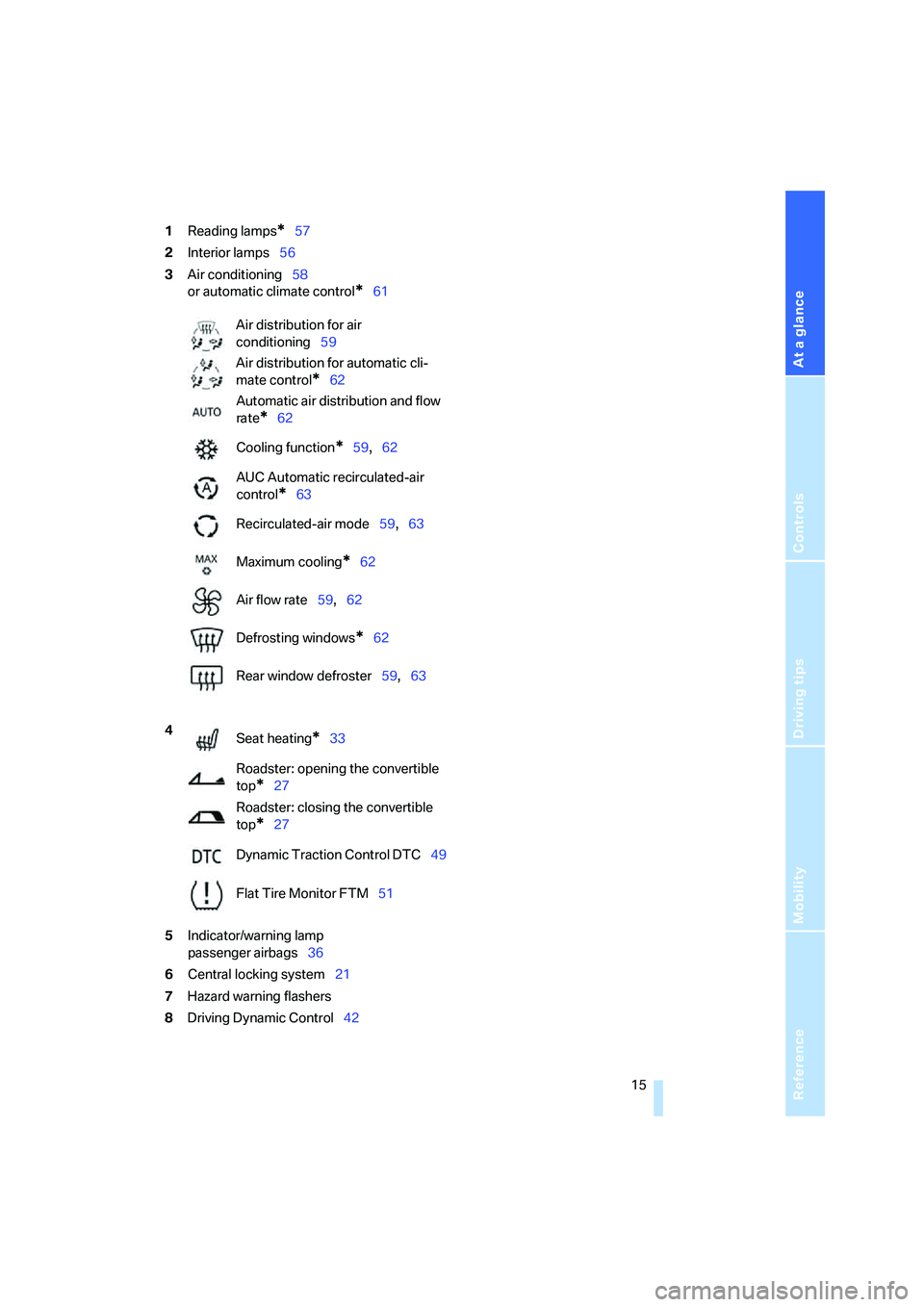
At a glance
Controls
Driving tips
Mobility Reference
15
1Reading lamps*57
2Interior lamps56
3Air conditioning58
or automatic climate control
*61
5Indicator/warning lamp
passenger airbags36
6Central locking system21
7Hazard warning flashers
8Driving Dynamic Control42 Air distribution for air
conditioning59
Air distribution for automatic cli-
mate control
*62
Automatic air distribution and flow
rate
*62
Cooling function
*59,62
AUC Automatic recirculated-air
control
*63
Recirculated-air mode59,63
Maximum cooling
*62
Air flow rate59,62
Defrosting windows
*62
Rear window defroster59,63
4
Seat heating
*33
Roadster: opening the convertible
top
*27
Roadster: closing the convertible
top
*27
Dynamic Traction Control DTC49
Flat Tire Monitor FTM51
Page 29 of 128
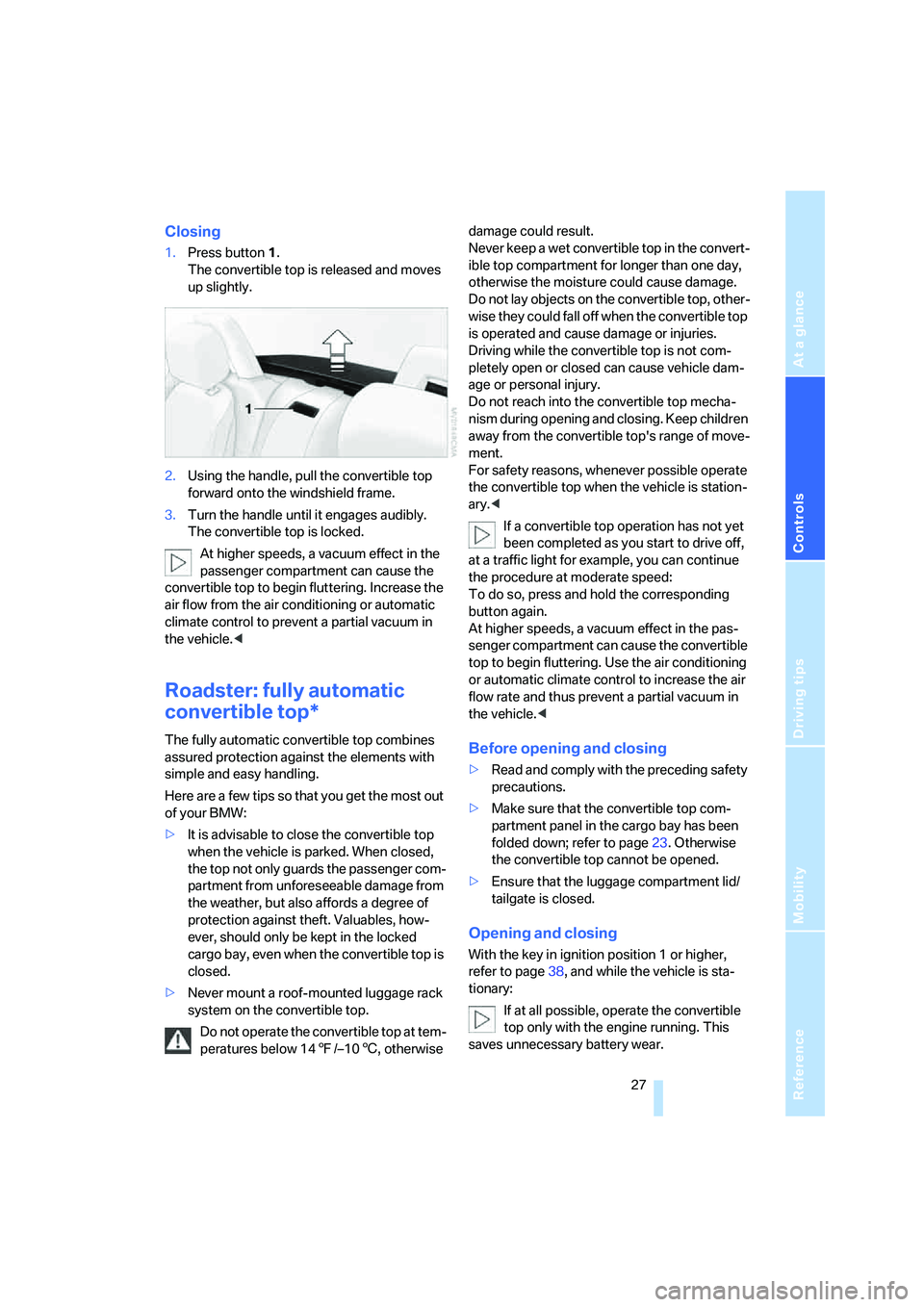
Reference
At a glance
Controls
Driving tips
Mobility
27
Closing
1.Press button1.
The convertible top is released and moves
up slightly.
2.Using the handle, pull the convertible top
forward onto the windshield frame.
3.Turn the handle until it engages audibly.
The convertible top is locked.
At higher speeds, a vacuum effect in the
passenger compartment can cause the
convertible top to begin fluttering. Increase the
air flow from the air conditioning or automatic
climate control to prevent a partial vacuum in
the vehicle.<
Roadster: fully automatic
convertible top*
The fully automatic convertible top combines
assured protection against the elements with
simple and easy handling.
Here are a few tips so that you get the most out
of your BMW:
>It is advisable to close the convertible top
when the vehicle is parked. When closed,
the top not only guards the passenger com-
partment from unforeseeable damage from
the weather, but also affords a degree of
protection against theft. Valuables, how-
ever, should only be kept in the locked
cargo bay, even when the convertible top is
closed.
>Never mount a roof-mounted luggage rack
system on the convertible top.
Do not operate the convertible top at tem-
peratures below 147/–106, otherwise damage could result.
Never keep a wet convertible top in the convert-
ible top compartment for longer than one day,
otherwise the moisture could cause damage.
Do not lay objects on the convertible top, other-
wise they could fall off when the convertible top
is operated and cause damage or injuries.
Driving while the convertible top is not com-
pletely open or closed can cause vehicle dam-
age or personal injury.
Do not reach into the convertible top mecha-
nism during opening and closing. Keep children
away from the convertible top's range of move-
ment.
For safety reasons, whenever possible operate
the convertible top when the vehicle is station-
ary.<
If a convertible top operation has not yet
been completed as you start to drive off,
at a traffic light for example, you can continue
the procedure at moderate speed:
To do so, press and hold the corresponding
button again.
At higher speeds, a vacuum effect in the pas-
senger compartment can cause the convertible
top to begin fluttering. Use the air conditioning
or automatic climate control to increase the air
flow rate and thus prevent a partial vacuum in
the vehicle.
precautions.
>Make sure that the convertible top com-
partment panel in the cargo bay has been
folded down; refer to page23. Otherwise
the convertible top cannot be opened.
>Ensure that the luggage compartment lid/
tailgate is closed.
Opening and closing
With the key in ignition position 1 or higher,
refer to page38, and while the vehicle is sta-
tionary:
If at all possible, operate the convertible
top only with the engine running. This
saves unnecessary battery wear.
Page 60 of 128
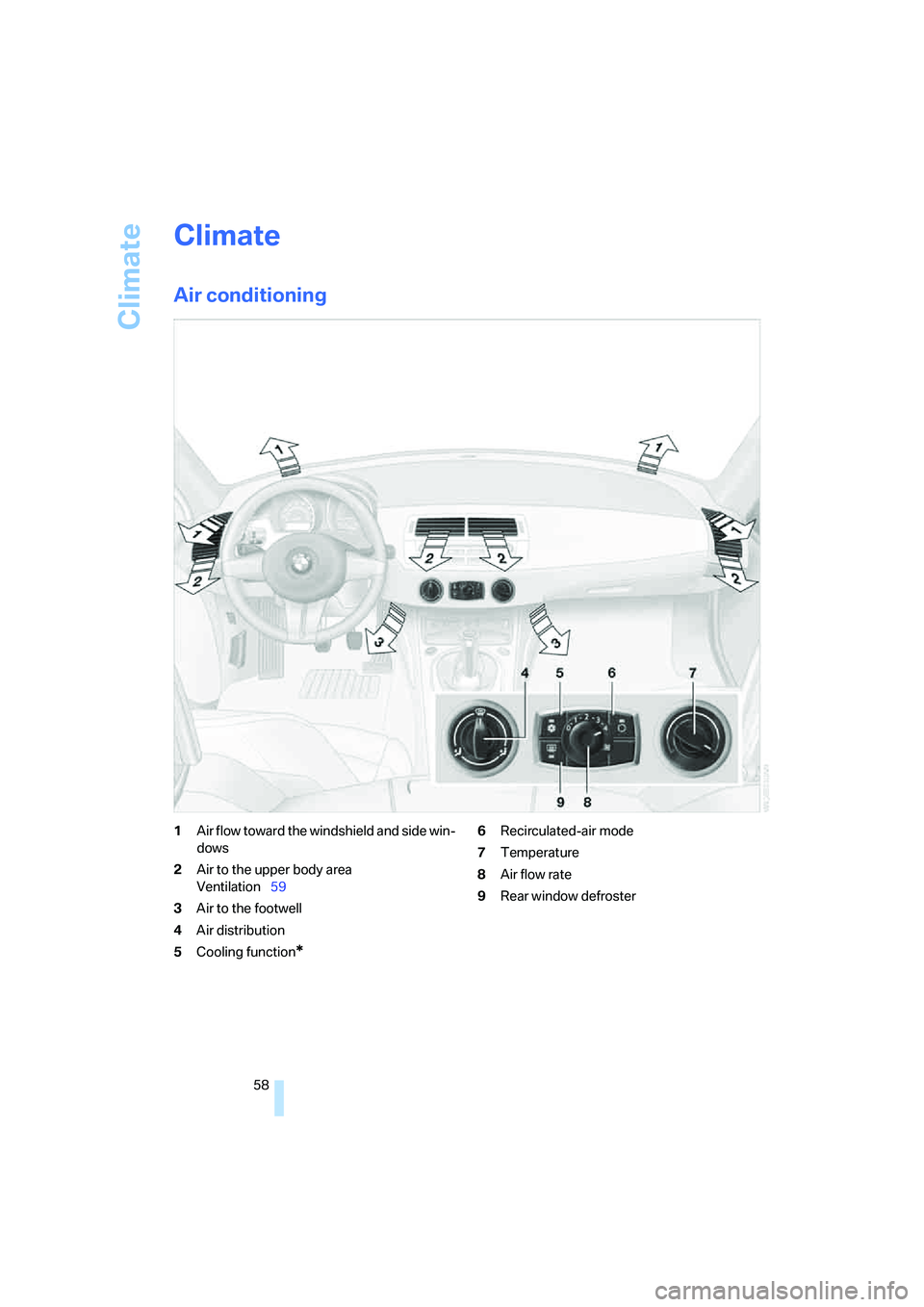
Climate
58
Climate
Air conditioning
1Air flow toward the windshield and side win-
dows
2Air to the upper body area
Ventilation59
3Air to the footwell
4Air distribution
5Cooling function
*
6Recirculated-air mode
7Temperature
8Air flow rate
9Rear window defroster
Page 61 of 128
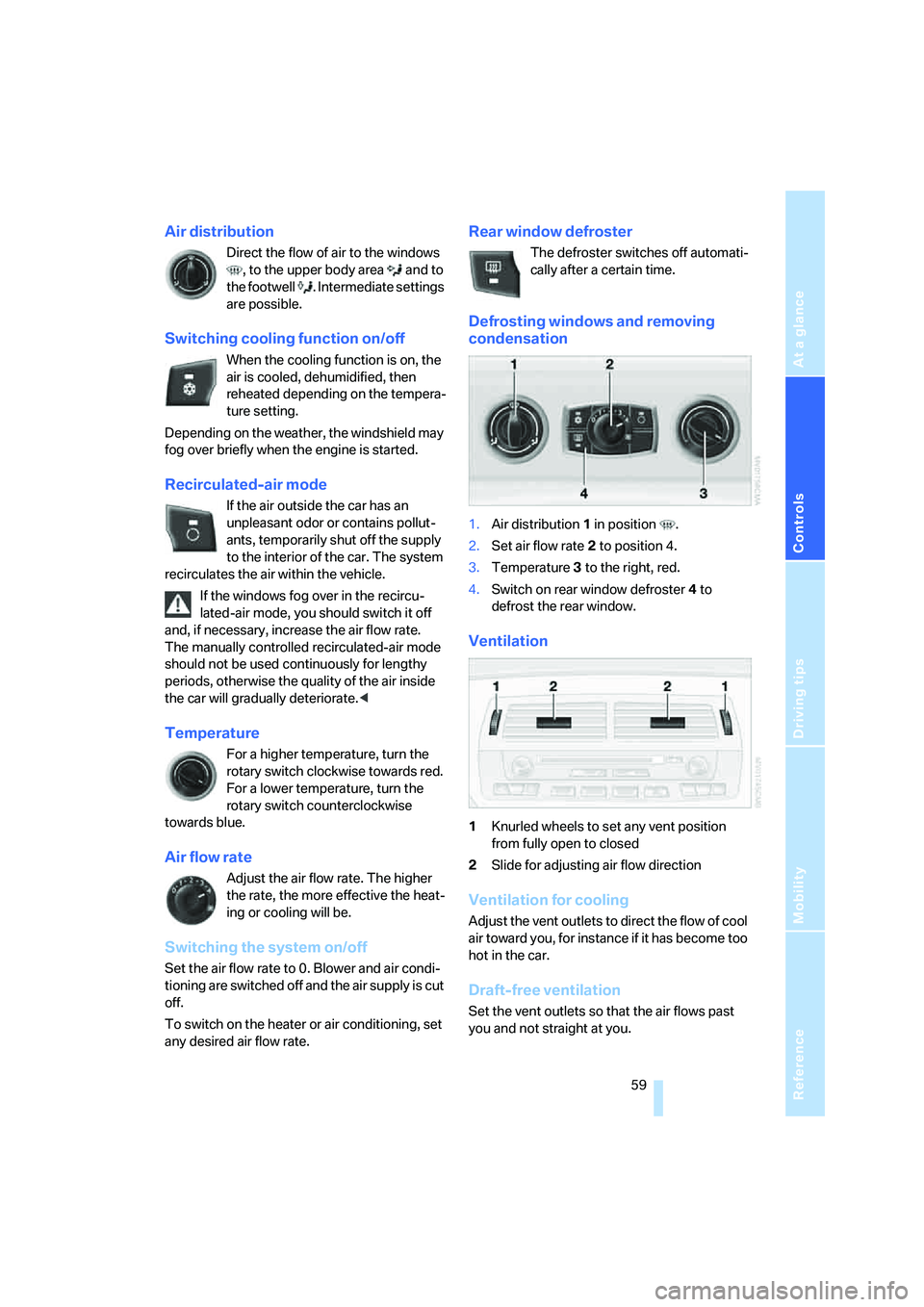
Reference
At a glance
Controls
Driving tips
Mobility
59
Air distribution
Direct the flow of air to the windows
, to the upper body area and to
the footwell . Intermediate settings
are possible.
Switching cooling function on/off
When the cooling function is on, the
air is cooled, dehumidified, then
reheated depending on the tempera-
ture setting.
Depending on the weather, the windshield may
fog over briefly when the engine is started.
Recirculated-air mode
If the air outside the car has an
unpleasant odor or contains pollut-
ants, temporarily shut off the supply
to the interior of the car. The system
recirculates the air within the vehicle.
If the windows fog over in the recircu-
lated-air mode, you should switch it off
and, if necessary, increase the air flow rate.
The manually controlled recirculated-air mode
should not be used continuously for lengthy
periods, otherwise the quality of the air inside
the car will gradually deteriorate.<
Temperature
For a higher temperature, turn the
rotary switch clockwise towards red.
For a lower temperature, turn the
rotary switch counterclockwise
towards blue.
Air flow rate
Adjust the air flow rate. The higher
the rate, the more effective the heat-
ing or cooling will be.
Switching the system on/off
Set the air flow rate to 0. Blower and air condi-
tioning are switched off and the air supply is cut
off.
To switch on the heater or air conditioning, set
any desired air flow rate.
Rear window defroster
The defroster switches off automati-
cally after a certain time.
Defrosting windows and removing
condensation
1.Air distribution1 in position .
2.Set air flow rate 2 to position 4.
3.Temperature3 to the right, red.
4.Switch on rear window defroster 4 to
defrost the rear window.
Ventilation
1Knurled wheels to set any vent position
from fully open to closed
2Slide for adjusting air flow direction
Ventilation for cooling
Adjust the vent outlets to direct the flow of cool
air toward you, for instance if it has become too
hot in the car.
Draft-free ventilation
Set the vent outlets so that the air flows past
you and not straight at you.
Page 64 of 128
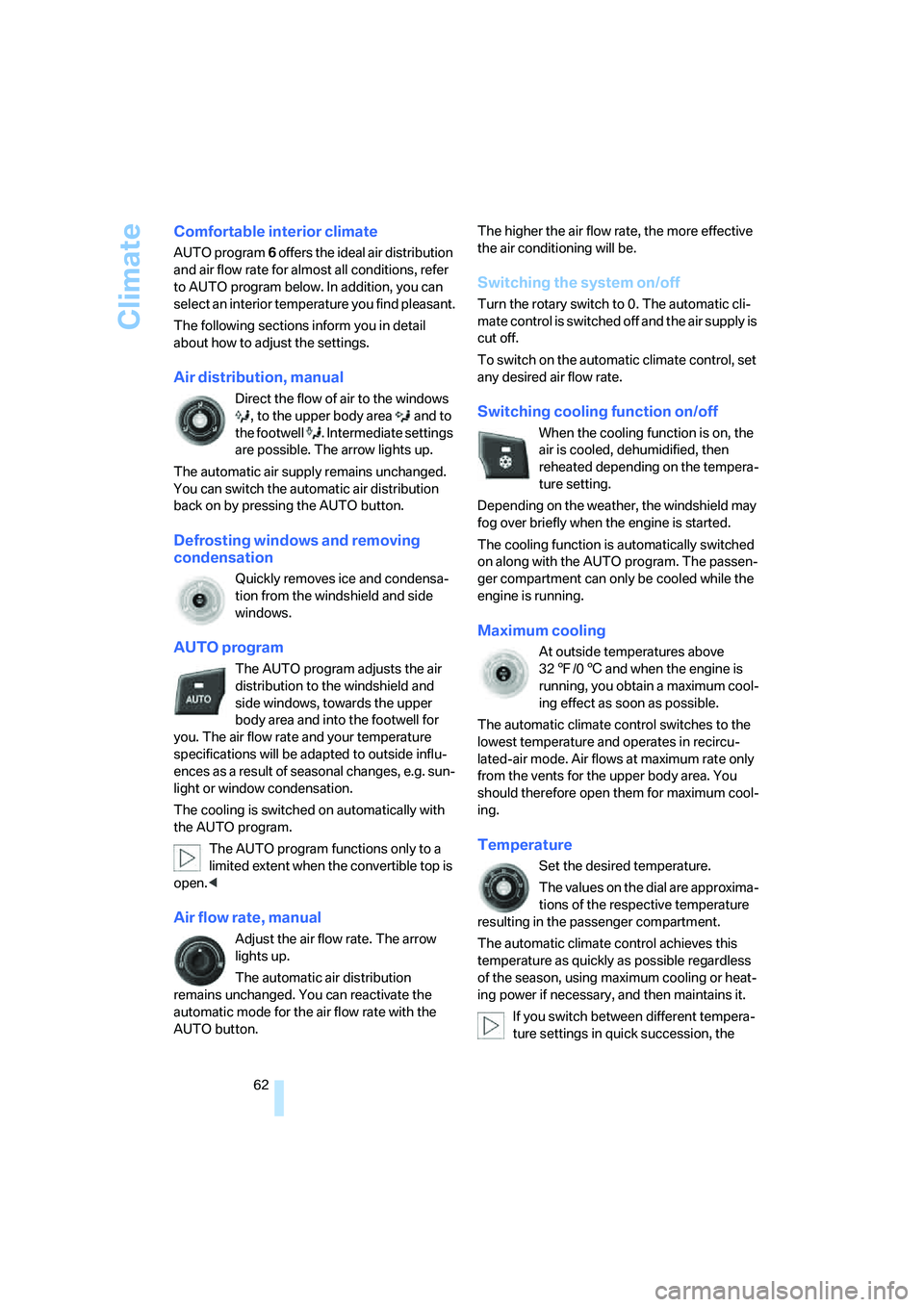
Climate
62
Comfortable interior climate
AUTO program 6 offers the ideal air distribution
and air flow rate for almost all conditions, refer
to AUTO program below. In addition, you can
select an interior temperature you find pleasant.
The following sections inform you in detail
about how to adjust the settings.
Air distribution, manual
Direct the flow of air to the windows
, to the upper body area and to
the footwell . Intermediate settings
are possible. The arrow lights up.
The automatic air supply remains unchanged.
You can switch the automatic air distribution
back on by pressing the AUTO button.
Defrosting windows and removing
condensation
Quickly removes ice and condensa-
tion from the windshield and side
windows.
AUTO program
The AUTO program adjusts the air
distribution to the windshield and
side windows, towards the upper
body area and into the footwell for
you. The air flow rate and your temperature
specifications will be adapted to outside influ-
ences as a result of seasonal changes, e.g. sun-
light or window condensation.
The cooling is switched on automatically with
the AUTO program.
The AUTO program functions only to a
limited extent when the convertible top is
open.<
Air flow rate, manual
Adjust the air flow rate. The arrow
lights up.
The automatic air distribution
remains unchanged. You can reactivate the
automatic mode for the air flow rate with the
AUTO button.The higher the air flow rate, the more effective
the air conditioning will be.
Switching the system on/off
Turn the rotary switch to 0. The automatic cli-
mate control is switched off and the air supply is
cut off.
To switch on the automatic climate control, set
any desired air flow rate.
Switching cooling function on/off
When the cooling function is on, the
air is cooled, dehumidified, then
reheated depending on the tempera-
ture setting.
Depending on the weather, the windshield may
fog over briefly when the engine is started.
The cooling function is automatically switched
on along with the AUTO program. The passen-
ger compartment can only be cooled while the
engine is running.
Maximum cooling
At outside temperatures above
327/06 and when the engine is
running, you obtain a maximum cool-
ing effect as soon as possible.
The automatic climate control switches to the
lowest temperature and operates in recircu-
lated-air mode. Air flows at maximum rate only
from the vents for the upper body area. You
should therefore open them for maximum cool-
ing.
Temperature
Set the desired temperature.
The values on the dial are approxima-
tions of the respective temperature
resulting in the passenger compartment.
The automatic climate control achieves this
temperature as quickly as possible regardless
of the season, using maximum cooling or heat-
ing power if necessary, and then maintains it.
If you switch between different tempera-
ture settings in quick succession, the
Page 72 of 128

Special operating instructions
70
Special operating instructions
Break-in procedures
Moving parts need to be given some time until
they can interact smoothly with one another. To
ensure that your vehicle provides maximum
economy throughout a long service life, we
request that you observe the following:
Always obey all official speed limits.
Engine and differential
Up to 1,200 miles/2,000 km
Drive at varying engine and road speeds, but do
not exceed 4,500 rpm or 100 mph/160 km/h.
Refrain from using full throttle and avoid press-
ing the accelerator beyond the kickdown point.
After driving 1,200 miles/2,000 km
Engine and vehicle speeds can be gradually
increased.
Tires
Due to technical factors associated with their
manufacture, tires do not achieve their full trac-
tion potential until an initial break-in period has
elapsed. Therefore, drive cautiously during the
first 200 miles/300 km.
Brake system
Brakes require an initial break-in period of
approx. 300 miles/500 km to achieve optimized
contact and wear patterns between brake pads
and rotors. Drive cautiously during this break-in
period.
Clutch
The function of the clutch reaches its optimal
level only after a distance driven of approx.
300 miles/500 km. Shift gears carefully during
the break-in period.
After replacing components
The same break-in procedures should be
observed if any of the components mentioned
above have to be renewed in the course of the
vehicle's operating life.
Driving notes
Closing the luggage compartment lid/
tailgate
Operate the vehicle only when the lug-
gage compartment lid/tailgate is closed.
Otherwise, exhaust fumes could enter the inte-
rior of the vehicle.<
Should it be absolutely necessary to operate
the vehicle with the luggage compartment lid/
tailgate open:
1.Coupe: close both windows.
Roadster: close all windows if the convert-
ible top is closed.
2.Greatly increase the air flow from the air
conditioning or automatic climate control,
refer to page58 or61.
Hot exhaust system
In all vehicles, extremely high tempera-
tures are generated in the exhaust sys-
tem. Never remove the heat shields installed in
the area of the exhaust system, nor apply
undercoating to their surfaces. When driving,
standing at idle or parking the vehicle, take care
to avoid contact between the hot exhaust sys-
tem and flammable materials, e.g. hay, leaves,
grass, etc. Such contact could lead to a fire,
resulting in serious personal injury and property
damage.<
Mobile communications in the vehicle
BMW advises against using mobile com-
munications devices, e.g. mobile phones,
inside the vehicle without connecting them
directly to an outside antenna. Otherwise, it
Page 74 of 128
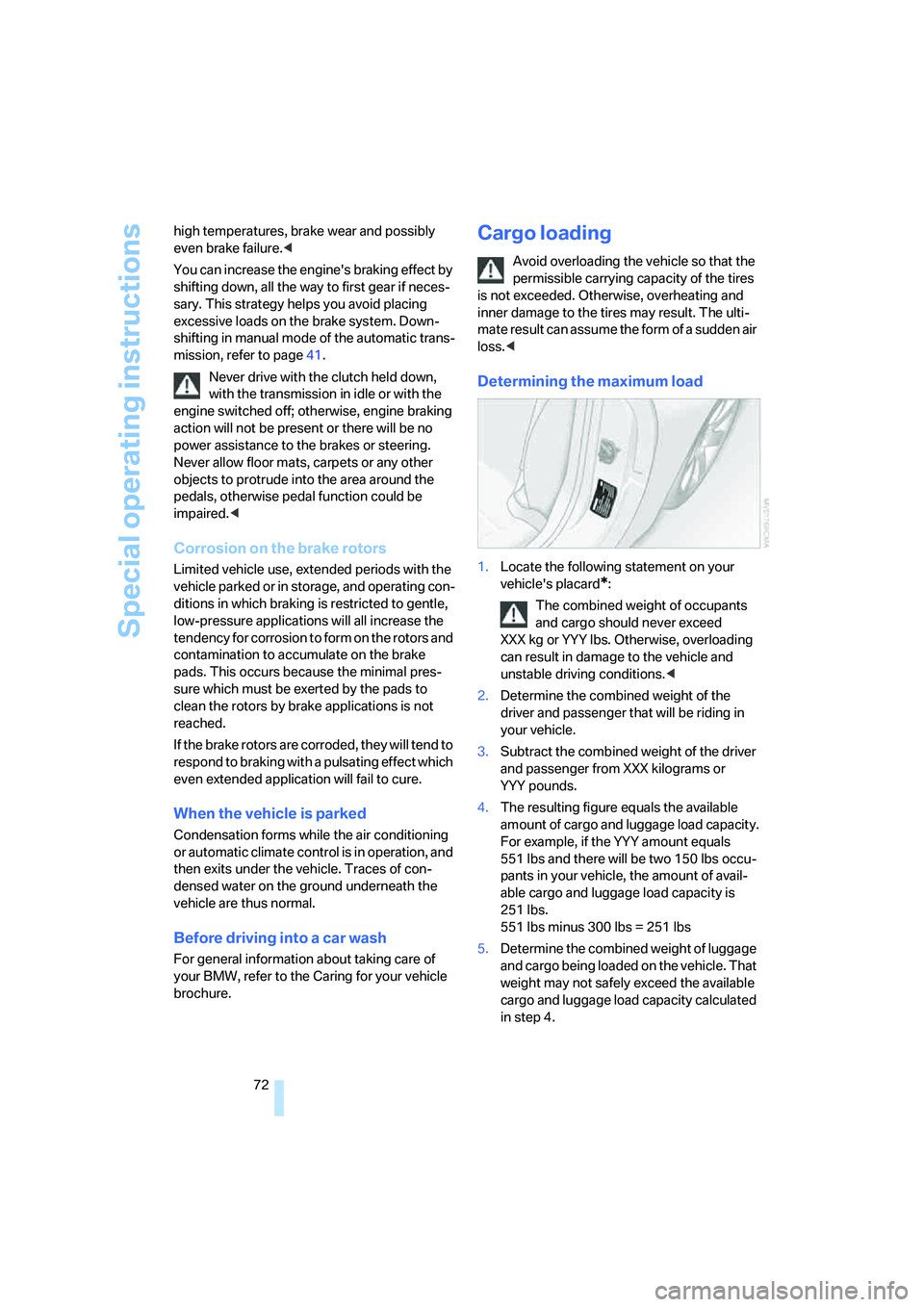
Special operating instructions
72 high temperatures, brake wear and possibly
even brake failure.<
You can increase the engine's braking effect by
shifting down, all the way to first gear if neces-
sary. This strategy helps you avoid placing
excessive loads on the brake system. Down-
shifting in manual mode of the automatic trans-
mission, refer to page41.
Never drive with the clutch held down,
with the transmission in idle or with the
engine switched off; otherwise, engine braking
action will not be present or there will be no
power assistance to the brakes or steering.
Never allow floor mats, carpets or any other
objects to protrude into the area around the
pedals, otherwise pedal function could be
impaired.<
Corrosion on the brake rotors
Limited vehicle use, extended periods with the
vehicle parked or in storage, and operating con-
ditions in which braking is restricted to gentle,
low-pressure applications will all increase the
tendency for corrosion to form on the rotors and
contamination to accumulate on the brake
pads. This occurs because the minimal pres-
sure which must be exerted by the pads to
clean the rotors by brake applications is not
reached.
If the brake rotors are corroded, they will tend to
respond to braking with a pulsating effect which
even extended application will fail to cure.
When the vehicle is parked
Condensation forms while the air conditioning
or automatic climate control is in operation, and
then exits under the vehicle. Traces of con-
densed water on the ground underneath the
vehicle are thus normal.
Before driving into a car wash
For general information about taking care of
your BMW, refer to the Caring for your vehicle
brochure.
Cargo loading
Avoid overloading the vehicle so that the
permissible carrying capacity of the tires
is not exceeded. Otherwise, overheating and
inner damage to the tires may result. The ulti-
mate result can assume the form of a sudden air
loss.<
Determining the maximum load
1.Locate the following statement on your
vehicle's placard
*:
The combined weight of occupants
and cargo should never exceed
XXX kg or YYY lbs. Otherwise, overloading
can result in damage to the vehicle and
unstable driving conditions.<
2.Determine the combined weight of the
driver and passenger that will be riding in
your vehicle.
3.Subtract the combined weight of the driver
and passenger from XXX kilograms or
YYY pounds.
4.The resulting figure equals the available
amount of cargo and luggage load capacity.
For example, if the YYY amount equals
551 lbs and there will be two 150 lbs occu-
pants in your vehicle, the amount of avail-
able cargo and luggage load capacity is
251 lbs.
551 lbs minus 300 lbs = 251 lbs
5.Determine the combined weight of luggage
and cargo being loaded on the vehicle. That
weight may not safely exceed the available
cargo and luggage load capacity calculated
in step 4.
Page 114 of 128

Everything from A to Z
112
Everything from A to Z
Index
A
ABS Antilock Brake
System49
– indicator lamp12
Accident, refer to Emergency
call98
Acknowledgment signal for
locking/unlocking vehicle19
Activated-charcoal filter for
automatic climate control63
Additives
– coolant89
– engine oil89
Adjusting
– seats30
Adjusting the thigh support32
Airbags52
– deactivating36
– indicator/warning lamp13
– passenger airbags indicator
lamp36
– reactivation36
– safe seating position30
Airbag switch, refer to Key
switch for passenger
airbags35
Air conditioning58
Air-conditioning operation,
refer to Cooling
function59,62
Air distribution
– air conditioning59
– automatic climate control62
– individual59,62
Air flow rate
– air conditioning59
– automatic climate control62
Airing out, refer to
Ventilation59,63
Air outlets, refer to
Ventilation59,63Air pressure, refer to Tire
inflation pressure80
Air recirculation, refer to
Recirculated-air
mode59,63
AKI, refer to Fuel
specifications79
Alarm system23
– avoiding unintentional
alarms24
– interior motion sensor24
– switching off an alarm24
– tilt alarm sensor24
All-season tires, refer to
Winter tires83,85
Ambient air, refer to
Recirculated-air
mode59,63
Ambient temperature
display46
Antenna, refer to the Caring
for your vehicle brochure
Antifreeze44,89
– coolant89
– washer fluids44
Antilock Brake System
ABS49
– indicator/warning lamp12
– indicator lamp13
Anti-theft alarm system, refer
to Alarm system23
Anti-theft protection19,23
Approved engine oils89
Artificial leather, refer to the
Caring for your vehicle
brochure
Ashtray65
Assistance systems, refer to
Driving stability control
systems49
AUC Automatic recirculated-
air control63Automatic
– air distribution62
– air flow rate62
– cruise control44
– headlamp control55
– luggage compartment lid
operation22
– recirculated-air control
AUC63
– tailgate operation21
Automatic car wash, refer to
the Caring for your vehicle
brochure
Automatic climate control61
Automatic convertible top27
Automatic lamps55
Automatic transmission with
Steptronic40
– indicator lamp13
– interlock38,40
– selector lever41
– selector lever lock40
– shiftlock40
– shift paddles on steering
wheel41
– towing the vehicle101
– tow-starting101
AUTO program for automatic
climate control62
Average fuel consumption48
– setting unit of measure48
Average speed48
– setting unit of measure48
Avoiding unintentional
alarms24
Axle loads, refer to
Weights109
B
Backrests, refer to Seat
adjustment31